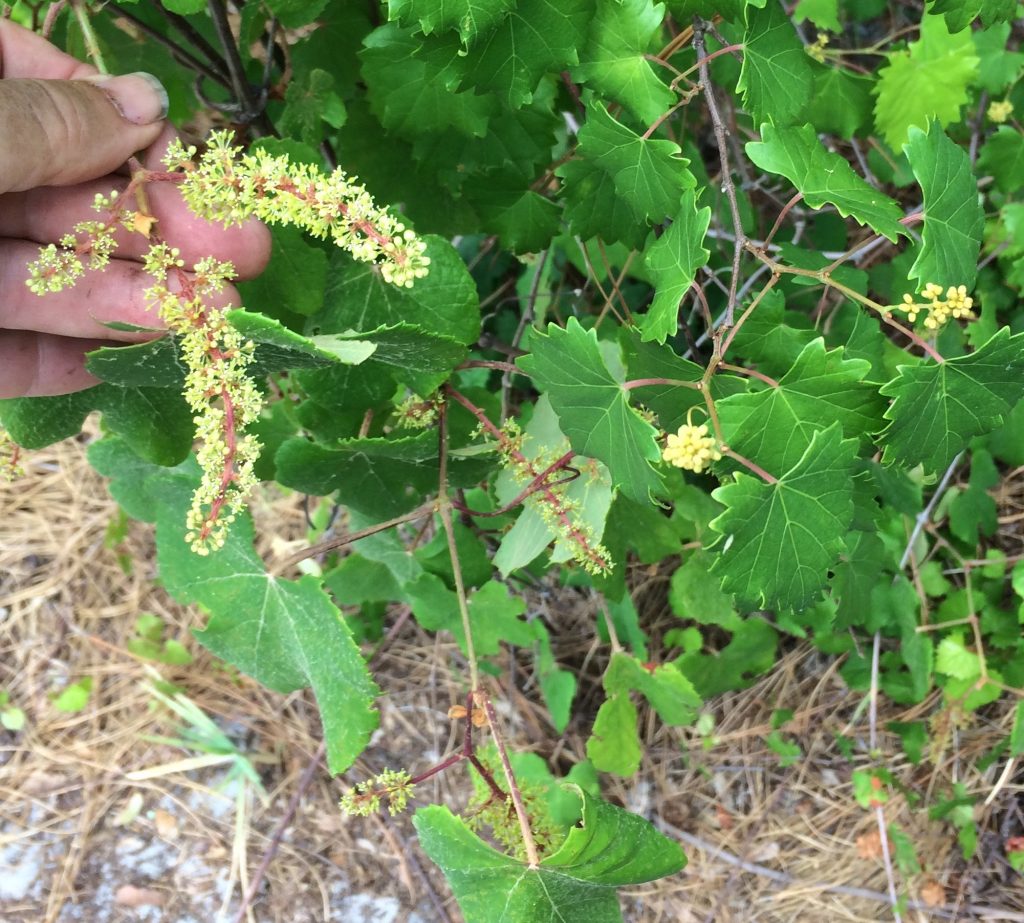
Two different species of grapes blossoming next to each other, a bunching forked tendril grape on our left; a clustering single tendril grape on our right. Seen a Wickham Park . Photo by Green Deane
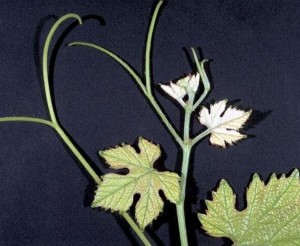
Forked-tendril species produce better grapes. Photo by Green Deane
Our local muscadine grapes are fickle, unreliable. Vitis munsoniana and V. rotundo rarely fruit irregularly. They can skip several years between fruitings. When they are going to fruitthey start now with blossoms ending with grapes ripening about September. Noticing where the grapes are blossoming now can save time this fall. Vitis munsoniana and V. rotundo are “single tendril” grapes with clusters of acidic grapes and are one of two large groups of grapes locally. The other group is forked tendril, they fruit regularly have sweet grapes that grow in a bunch. Clearly of the two one wants to find the forked tendril grape which is usually vitis aestivalis. Remember that grape seeds are teaardrop shaped. You can read about grapes here a video here.
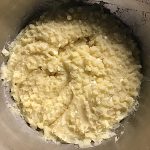
fermented mashed potatos.Photo by Green Deane
If you study cooking in the 1800s nothing went to waste. Many recipes from that era are basically making a meal out of leftovers. Such as turning stale bread into a pie. One trick from that time period is fermenting mashed potatoes (no not into vodka.) Mixing yogurt into mashed potatoes and letting it ferment a few days, kind of like building in sour cream. Once fermented treat/eat like yogurt. When I was growing up my mother professed to being a horrible cook while her mother — who grew up in poverty — was well-known for being a great cook. A while after I started studying 18th century cooking I realized my mother’s cooking wasn’t bad but centuries old. In fact something called The Poor man’s Meal from the depression era was something we had at least two nights a weekImagine my surprise when I saw a video of it on You Tube entitled depression era cooking!
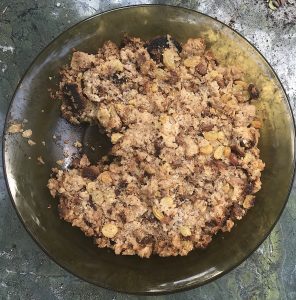 “Beggar’s pudding” from 1773 was stale bread repurposed for your family or the poor. I had half a loaf of homemade sour dough leftover. It was a good candidate for Beggar’s Pudding which is: Bread, sherry, ginger, currants or raisins. In the 1700s almost any fruit could have been used and cider for sherry. Ginger was an inexpensive seasoning you could grow at home. Many recipes from the 1700s don’t include amounts. For this I used that half a loaf of bead, a cup of marsala instead of sherry, a tablespoon of ground ginger, a teaspoon of coarse salt, a grind of nutmeg, a cup of golden raisins and a third of a cup of white sugar. Pour the hot water over the bread to soften, pour off any excess water, mix all the ingredients then put into a buttered pie dish, dot the top with butter and bake at 325F for 35 minutes. Serve cold. Brown sugar would be better
“Beggar’s pudding” from 1773 was stale bread repurposed for your family or the poor. I had half a loaf of homemade sour dough leftover. It was a good candidate for Beggar’s Pudding which is: Bread, sherry, ginger, currants or raisins. In the 1700s almost any fruit could have been used and cider for sherry. Ginger was an inexpensive seasoning you could grow at home. Many recipes from the 1700s don’t include amounts. For this I used that half a loaf of bead, a cup of marsala instead of sherry, a tablespoon of ground ginger, a teaspoon of coarse salt, a grind of nutmeg, a cup of golden raisins and a third of a cup of white sugar. Pour the hot water over the bread to soften, pour off any excess water, mix all the ingredients then put into a buttered pie dish, dot the top with butter and bake at 325F for 35 minutes. Serve cold. Brown sugar would be better
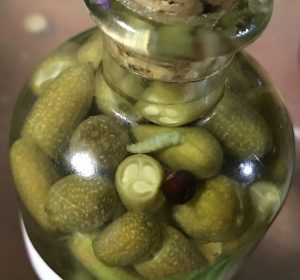
Fermenting the lighter green segmented cucumber worm. Phto by Green Deane
In Ft Pierce last week we saw a lot of ripe creeping cucumbers, Melothria pendula, so I decided to ferment some. If you look closely you’ll see a worm being pickled. As I’m sure I’ve already consumed some worms in the past I won’t fetch it out until the pickling process is complete. Fermenting food for preservation is a simple processed. While there can be variations, it is basically one tablespoon of non-iodized salt per cup of water. Pour the brine over the non-washed material being pickled making sure what you are pickling is kept submerged in the solution (that which pops out will mold.) Let it ferment for about three weeks. We will try these in a future class (Sorry there is only one worm to taste.) The salt discourages bad bacteria but encourages lacto bacteria which eats the carbohydrates turning them into tart acidic acid
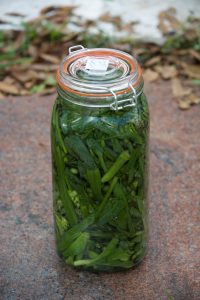
Fermented Spiderworts. Photo by Green Deane
Blooming strongly now are Spiderworts. Most of them have a blue blosssom. The entire plant above ground is edible. I often chop them and ferment them into a sauerkraut. They are more fiberous than cabbage making a tough sauerkraut but tasty. Occasionally you will see one with a gray or white or red blossom. Officially there are nine different species of spiderworts locally. The one I see most often is Tradescantia ohiensis.
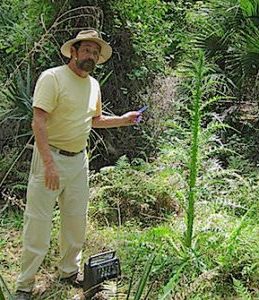
Foraging classes are held rain, shine, hot or cold. Photo by Nermina Krenata
Visiting two favored locations this weekend, Larago where there’s a lot of wild garlic, and mead garden which has a lot of vaiety
Saturday April 9th,Eagle Park Lake, 1800 Keene Road, Largo, FL 33771, 9 a.m. to noon, meet at the pavilion nest to the dog park.
Sunday April 10th, Mead Gardens, 1500 S. Denning Dr., Winter Park, FL 32789. 9 a.m. to noon Meet at the bathrooms.
Saturday April 16th, Spruce Creek Park, 6250 Ridgewood Ave. Port Orange, 32127. 9 a.m. to noon Meet at the pavilion
Saturday April 23rd, Bayshore Live Oak Park, Bayshore Drive. Port Charlotte. 9 a.m. to noon, meet at the parking lot of Ganyard St, and Bayshore Blvd.
Saturday April 30th,Saturday April 30th Jervey Gantt Recreation Complex, 2390 SE 36th Ave., Ocala, FL, 34471.9 a.m. to noon. Meet at the entrance to the pool, aka Aquatic Fun Center. To meet the demands of the city of Ocala, this is a free class, If you want to make a donation afterwards that is at your discretion.
Sunday May 1st, Wickham Park: 2500 Parkway Drive, Melbourne, FL 32935-2335. 9 am. to noon meet at the dog park inside the park.
Saturday/Sunday May 7th & 8th, Honea Path, South Carolina, classes at 9 a.m. and 1 p.m. each day.
Saturday May 14th Dreher Park, 1200 Southern Blvd., West Palm Beach, 33405. 9 a. m. to noon Meet just north of the science center.
Sunday may 15th, Mead Gardens, 1500 S. Denning Dr., Winter Park, FL 32789. 9 a.m. to noon Meet at the bathrooms.
For more information, to pre-pay or sign up go here
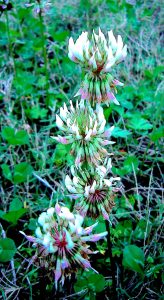
Clover prefers low nitrogen soil.
Clover is one of those wild edibles that is both overstated and understated. The overstatement is from writers who offer it as a great human food full of this and that to keep us healthy. The understated part is that it can harbor a fungus that inhibits clotting and somewhere around a half-a-cup of raw leaves can make you throw up. Individual experience, of course, can vary and there are several different species of clover with different characteristics. Pictured here is a nice little White Clover which is blossoming now mostly in lawns and athletic fields. A few leaves can be eaten raw. They are high in protein for a leaf. The blossom fresh or quickly dried can be used for tea. There is also Crimson, Red, Sweet and even Tick Clover.
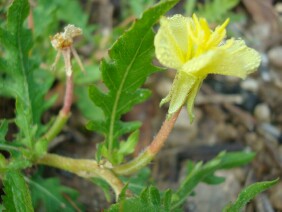
Oenothera laciniata, cutleaf evening primrose
There are two blossoms you might be seeing now. One is the non-edible vine Carolina jassamine (Gelsemium Sempervirens.) You will see it draping over fences and bushes. The other in the southern version of the Evening Primrose, generally considered not edible (but I haven’t proven that to myself.) The northern version of the Evening Primrose, Oenothera biennis, is called a “lost vegetable.” It was cultivated in Europe for about a century. There is a debate whether it is native to Europe or North America. Our Evening Primrose is O. laciniata, or the Cutleaf Evening-primrose. Unlike its northern sibling our local Evening Primrose does not grow tall, is a ground hugger, and is not considered edible. I have been meaning to try a little part of the blossom. A quarter of a century ago Forager Emeritus Dick Deuerling told me it was not edible. That said, Dick had texture issues and said he only ate the “good stuff.” So he could have been saying he didn’t eat it. It’s a plant I’ve been meaning to explore. The natives ate several other Evening Primroses including O. albicaulis, O. biennis, O elata ssp. hookeri, and O. triloba. Another evening Primrose you might find in the northern part of the state is O. fruticosa. It’s not considered edible, either.
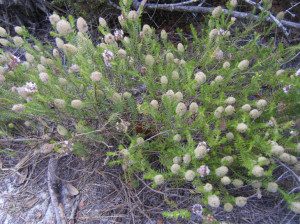
Florida Pennyroyal is also in blossom. Photo by Green Deane
If you are one to wander around sandy scrub in Florida this time of year you will see the low blooms of the Florida Pennyroyal. It’s quite an unusual plant in that it is monotypic, meaning the only plant in its genus. It’s found along the Central Florida Ridge though I have seen it also on the east coast of the state. There are a few plants in the Bahamas and maybe one or two in southern Georgia. It has the unmistakable aroma of pennyroyal. A species that looks vaguely similar, Florida Rosemary, has no noticeable strong aroma. Florida Pennyroyal used to be the third most common nectar plant in the state but fell off for some unknown reason and was replaced by Bidens alba, the Spanish Needles. Florida Pennyroyal was used extensively by the natives and has culinary uses. To read more about it go here.

Green Deane videos are now available on a USB.
My nine-DVD set of 135 videos has been phased out and replaced by 171-videos on a 128-GB USB, see left. The USB videos are the same videos I have on You Tube. Some people like to have their own copy especially if social order falters. The USB videos have to be copied to your computer to play. If you want to order the USB go to the DVD/USB order button on the top right of this page or click here. That will take you to an order form. Or you can make a $99 donation, which tells me it is for the USB (include a snail-mail address.) I’d like to thank all of you who ordered the DVD set over the years which required me to burn over 5,000 DVDs individually. I had to stop making them as few programs now will read the ISO files to copy them. Burning a set also took about three hours.

Green Deane Forum
Want to identify a plant? Perhaps you’re looking for a foraging reference? You might have a UFO, an Unidentified Flowering Object, you want identified. On the Green Deane Forum we — including Green Deane and others from around the world — chat about foraging all year. And it’s not just about warm-weather plants or just North American flora. Many nations share common weeds so there’s a lot to talk about. There’s also more than weeds. The reference section has information for foraging around the world. There are also articles on food preservation, and forgotten skills from making bows to fermenting food. Recent topics include: Fermenting potatoeswith yogurt, make a water filter, nixtamalization at home, Stale Bread and Cod Liver Oil, Life’s a Grind, Killing Bugs with Tobacco Plugs, Eating weeds: Is it safe? Have they mutated? Not the Eastern Red Bug but the Pink Tabebuia, African Tulip Tree, Asparagus densiflorus, Green Deane’s Book… You can join the forum by clicking on the button on the upper right hand side of this page.
This is my weekly newsletter #502. If you want to subscribe to this free newsletter you can find the sign-up form in the menu at the top of the page. My website, EatTheWeeds.com, which is data secure, has over 1500 plants on it in some 428 articles. I wrote every one myself, no cut and paste.
To donate to the Green Deane Newsletter click here.


Picayune Strand State Forest was loaded with pennyroyal a month ago, going in a couple of weeks, hope it’s still there, the smell was heavenly.
Pickled worms…Great protein
What a great newsletter. Really liked the bit about the Beggars pudding and the fermenting of the creeping cucumbers and the spiderwort. I noticed how large the pieces of your spiderwort are…. Think it would be ok to put in food processor and make small pieces like the consistency of maybe coleslaw or regular sauerkraut and then add brine?